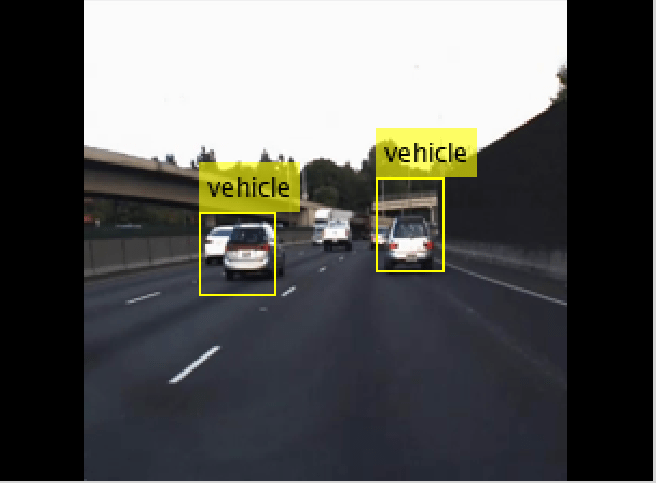Generate C++ Code for Object Detection Using YOLO v2 and Intel MKL-DNN
This example shows how to generate C++ code for the YOLO v2 Object detection network on an Intel® processor. The generated code uses the Intel Math Kernel Library for Deep Neural Networks (MKL-DNN).
有关更多信息,请参见Object Detection Using YOLO v2 Deep Learning(计算机视觉的工具箱).
Prerequisites
Intel Math Kernel Library for Deep Neural Networks (MKL-DNN)
ReferMKLDNN CPU Supportto know the list of processors that supports MKL-DNN library
MATLAB® Coder™ for C++ code generation
MATLAB Coder Interface for Deep Learning support package
Deep Learning Toolbox™ for using the
DAGNetworkobjectComputer Vision Toolbox™ for video I/O operations
For more information on the supported versions of the compilers and libraries, seeThird-Party Hardware and Software(MATLAB Coder).
This example is supported on Linux®, Windows®, and macOS platforms and not supported for MATLAB Online.
Get the PretrainedDAGNetworkObject
The DAG network contains 150 layers including convolution, ReLU, and batch normalization layers and the YOLO v2 transform and YOLO v2 output layers.
net = getYOLOv2();
Downloading pretrained detector (98 MB)...
Use the commandnet.Layersto see all the layers of the network.
net.Layers
Code Generation foryolov2_detectionFunction
Theyolov2_detectionfunction attached with the example takes an image input and runs the detector on the image using the network saved inyolov2ResNet50VehicleExample.mat. The function loads the network object fromyolov2ResNet50VehicleExample.matinto a persistent variableyolov2Obj. Subsequent calls to the function reuse the persistent object for detection.
type('yolov2_detection.m')
function outImg = yolov2_detection(in) % Copyright 2018-2019 The MathWorks, Inc. % A persistent object yolov2Obj is used to load the YOLOv2ObjectDetector object. % At the first call to this function, the persistent object is constructed and % set up. Subsequent calls to the function reuse the same object to call detection % on inputs, thus avoiding having to reconstruct and reload the % network object. persistent yolov2Obj; if isempty(yolov2Obj) yolov2Obj = coder.loadDeepLearningNetwork('yolov2ResNet50VehicleExample.mat'); end % pass in input [bboxes,~,labels] = yolov2Obj.detect(in,'Threshold',0.5); outImg = in; % convert categorical labels to cell array of character vectors for MATLAB % execution if coder.target('MATLAB') labels = cellstr(labels); end if ~(isempty(bboxes) && isempty(labels)) % Annotate detections in the image. outImg = insertObjectAnnotation(in,'rectangle',bboxes,labels); end
To generate code, create a code configuration object for a MEX target and set the target language to C++. Use thecoder.DeepLearningConfigfunction to create a MKL-DNN deep learning configuration object. Assign this object to theDeepLearningConfigproperty of the code configuration object. Specify the input size as an argument to thecodegencommand. In this example, the input layer size of the YOLO v2 network is[224,224,3].
cfg = coder.config('mex'); cfg.TargetLang ='C++'; cfg.DeepLearningConfig = coder.DeepLearningConfig('mkldnn'); codegen-configcfgyolov2_detection-args{ones(224,224,3,'uint8')}-report
Code generation successful: To view the report, open('codegen\mex\yolov2_detection\html\report.mldatx').
Run the Generated MEX Function on Example Input
Set up a video file reader and read the example input videohighway_lanechange.mp4. Create a video player to display the video and the output detections.
videoFile ='highway_lanechange.mp4'; videoFreader = vision.VideoFileReader(videoFile,'VideoOutputDataType',“uint8”); depVideoPlayer = vision.DeployableVideoPlayer('Size','Custom','CustomSize',[640 480]);
Read the video input frame by frame and detect the vehicles in the video by using the detector.
cont = ~isDone(videoFreader);whilecont I = step(videoFreader); in = imresize(I,[224,224]); out = yolov2_detection_mex(in); depVideoPlayer(out); cont = ~isDone(videoFreader) && isOpen(depVideoPlayer);% Exit the loop if the video player figure window is closedend

References
[1] Redmon, Joseph, and Ali Farhadi. "YOLO9000: Better, Faster, Stronger." In2017 IEEE Conference on Computer Vision and Pattern Recognition (CVPR), 6517–25. Honolulu, HI: IEEE, 2017.
See Also
coder.DeepLearningConfig(MATLAB Coder)|coder.hardware(MATLAB Coder)

